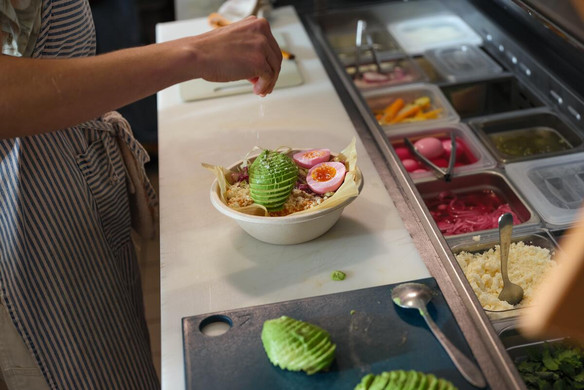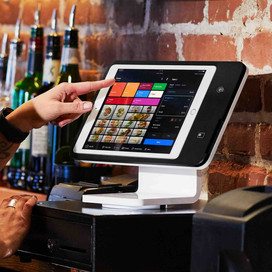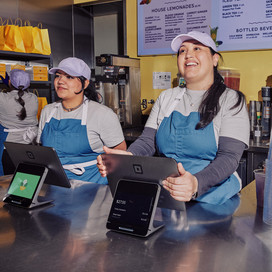Table of contents
Growing your restaurant to a point where you can franchise probably means you’re doing something right. It shows your restaurant has proven successful in its original location(s). And you’ve established a business model that people are ready — and willing — to bet their money on.
Overall, food franchises account for 30% of all franchise establishments in the U.S., according to research from franchise referral website Franchise Direct. And the number of franchises, particularly quick-service restaurant franchises, is on a projected growth track as aspiring entrepreneurs continue to embrace the franchise model.
While franchising your restaurant can open the door for huge business growth, the process is not for the faint of heart. It requires careful planning. To overcome challenges like rising inventory and labor costs, successful franchises are evolving their tech stack to include tools like self-serve kiosks, inventory management systems, and advanced point-of-sale systems to make things run smoothly as they scale. Before you embark on the journey to franchise your restaurant, here are some key steps to consider to ensure a painless transition.
What is a franchise? And what are the benefits of franchising your restaurant?
What makes a franchise?
Think of it this way: If you run a fast-food restaurant, you might decide to franchise your brand to expand your footprint into new locations. As the franchisor, you would grant individuals or groups (franchisees) the right to operate their own restaurants using your established brand, menu, and operational standards. In return, the franchisees would pay initial franchise fees and ongoing royalties and stick to your guidelines for quality, service, and branding. This arrangement allows you to grow your restaurant while providing your partners with a proven business model and support network.
To be clear, franchise success rates vary. As with any business endeavor, things like capital investment and the regulatory requirements involved add risk to the process. Plus, it can take a lot of effort to bring on franchisees. But a restaurant franchise can benefit both parties involved. As a franchisor, you can expand into new markets without making big investments upfront because your franchisees will shoulder most of the financial risks and setup costs. They will also pay royalty fees, typically 4%–12% of their revenue, which can be a significant revenue source for your restaurant. Additionally, they can act as local ambassadors, which can boost brand loyalty through their community engagement and marketing efforts.
On the other hand, franchisees can capitalize on the established brand recognition of the parent company, which can make it easier to attract customers. That can also be a lot easier than starting a business from scratch. For example, national television ads and social media campaigns run by the parent brand of a fast food chain can help a franchisee drive customer traffic to their specific location. Franchisees can also enjoy economies of scale in purchasing and other areas. For example, a franchisee of a popular coffee chain may get lower prices on coffee beans and equipment due to collective buying power negotiated by the franchisor for the entire franchise network.
Turning your restaurant business into a successful franchise
Now that you understand the ins and outs of restaurant franchises, let’s dive into the steps to consider as you begin your journey toward becoming one.
1. Establish a proven track record.
Before diving into franchising, it’s crucial to prove your restaurant’s success by running your own location(s) first. Having a couple of successful company-owned spots shows potential franchisees that your concept works and is worth investing in. It’s also a chance to fine-tune your business model based on factors like market demand, customer preferences, profit margins, and growth potential. Resources like the Square Restaurant Profitability Analysis Tool and Restaurant Startup and Expansion Analysis Tool can help you make these decisions.
It’s also important to create a strong brand identity. Consider investing in branding to differentiate your restaurant concept from competitors and create a compelling value proposition for franchisees. A clear brand identity signals stability and ensures consistency in branding, customer experience, and product offerings across all locations, which is essential for building customer trust and loyalty. Plus, it helps franchisees feel connected to the brand, which can motivate them to maintain high standards and provide great experiences.
2. Streamline your processes and procedures.
This is a critical step when transitioning into a franchise. It’s all about making sure your operations run smoothly and that everything stays consistent and efficient as you expand to new locations. Genevieve Weeks, founder of Tutu Schools Franchise, which has 34 locations, says having a growth mindset is crucial once you start considering a franchise. “Even if you’re in one location, streamline processes and procedures, write down what you need to know, and formalize everything,” says Weeks.
While Weeks runs a school franchise, her advice is valuable for anyone exploring the franchise model. “Make sure everything is codified and well thought out. This makes your business run more smoothly, so if you do expand, that information is always there. When we decided to franchise, we had to press pause and do that for a bit.”
To be well-prepared, you can start by writing down all the processes and procedures you use in your restaurant. This helps you see where you can make things better or more consistent. Look at what works best and make standard procedures for things like how you serve customers, prepare food, manage inventory, and train employees.
Speaking of employees, think about keeping them informed about the transition early on so they understand the changes that will occur and how their roles and responsibilities may be affected. This can be a good opportunity to ensure all employees get thorough training on the new franchise rules, how things work, and any policy changes. They need to know what their jobs are in the franchise and have the skills to do them well.
3. Secure legal and regulatory compliance.
Once you’ve sorted out your operations, the next step is to ensure you’re legally compliant. Follow all the rules and regulations for franchising, including disclosure laws, registrations, and agreements. In the U.S., for example, the Federal Trade Commission oversees franchise disclosure rules via the Franchise Rule. It can be helpful to seek legal advice so you can navigate these legal requirements properly.
4. Develop franchisee selection criteria.
After you’ve prepared your team and cleared the legal hurdles, it’s time to find the right partners for your business. Tommy Traynham, Senior Director of Technology at Taziki’s Cafe, a fast-casual Mediterranean restaurant franchise with over 90 locations, says this is often challenging.
“Finding partners who are as passionate about their stores as we are about ours is a challenge,” says Traynham. “You’d think that since people are putting their money on the line, their stores would be their top priority, but it’s not always so. There are plenty of entrepreneurs who believe they want to be a part of a franchise system, while what they really want is to build out their own ideas or their own passions. I don’t think a franchise system is really great for those types of people. [That’s why] we have a department, franchise development — that’s what we call it — that is dedicated to finding the right people.”
So, it’s crucial to develop clear criteria for selecting franchisees who are aligned with your brand’s values, vision, and culture. For example, if your restaurant emphasizes community engagement and sustainability, franchisees who demonstrate a clear commitment to these values through their personal and professional endeavors would be ideal candidates.
5. Build a supportive infrastructure.
A Franchise Motivation Survey Report found that franchise support/training is the second biggest reason people buy a franchise instead of starting their own business, with name recognition/use of a known business name being the most important reason.
This finding underscores the importance of not only building a powerful brand but also developing a strong support structure for prospective franchisees — your support system may be the reason why they buy into your franchise rather than the next business. Develop comprehensive training programs, operational manuals, resources, and tools to help franchisees succeed.
Getting the most out of your technology to propel you towards franchising
One of the biggest challenges of transitioning into a franchise is the increased complexity it introduces to your business operations. You will have to manage multiple locations and cultivate relationships with diverse business partners. This can be daunting without the right technology and systems. To ensure success, many teams invest in technology solutions and systems that help streamline operations, facilitate communication, and enhance efficiency across their franchise network.
Square for Franchises provides all the tools you need to manage your franchise efficiently, from payments to operations to marketing — all from a central hub. For example, you can seamlessly update menus in real time using the menu management tool, enhance customer satisfaction through loyalty programs, and effortlessly handle staff management and scheduling in mere minutes across all locations. Plus, with centralized reporting, you can keep a bird’s-eye view on how your business is doing across individual locations.
“Our franchise partners really like Square Marketing because they’re able to go in and create their own campaigns,” says Heather Stennis, director of marketing at Cinnaholic, a vegan bakery franchise with almost 40 locations. “We provide them with the graphics and images for our brand, and then they’re able to create their offer and word it according to their market,” explains Stennis.
Whatever technology you choose to adopt, think about prioritizing ease of use and simplicity because the system will be used by everyone involved in your franchise.
“It’s really helpful to be able to put Square in front of a new hire, and they just get it,” says Traynham. “It’s intuitive, not just for the employee on the front end, but also for the employee on the back end. In fact, when we went from Square POS to Square for Restaurants in one of our stores, it only took about 10 minutes for our entire staff to be completely fluent with Square for Restaurants. It’s just that easy to use.”
Expanding your restaurant into a franchise is both exciting and demanding. Every move requires careful attention, from streamlining your processes to defining franchisee selection criteria. Technology is crucial, too. By using tools like POS systems, inventory management systems, and digital marketing wisely, you can make your franchise successful, improve operations, and grow your business across multiple locations.
![]()













